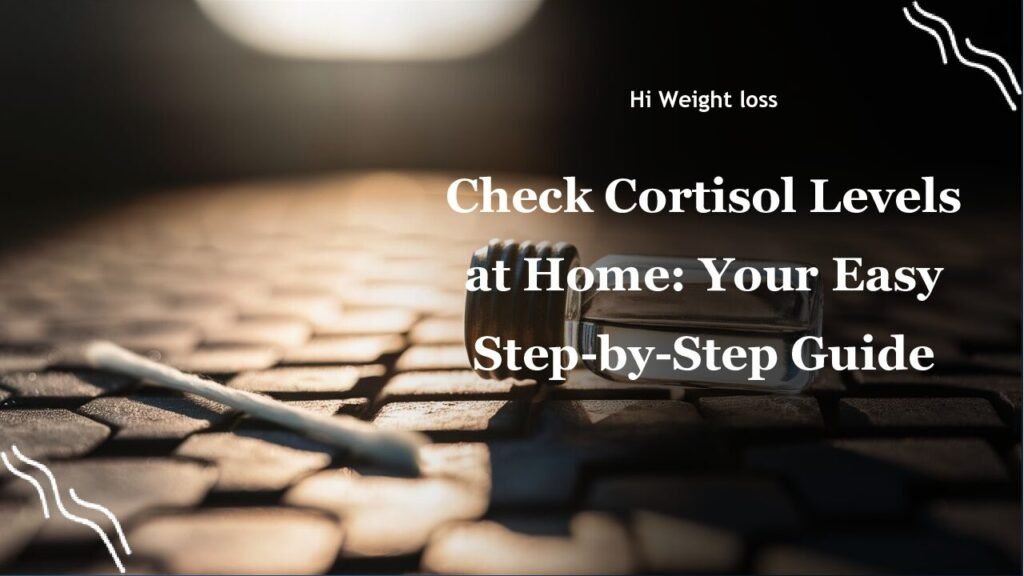Feeling constantly stressed and wondering if it’s affecting your health? It might be time to check your cortisol levels, the body’s primary stress hormone. High cortisol can lead to a variety of health issues. Knowing how to manage your stress and understanding your cortisol level can help you better navigate daily life. This article explores how you can easily check your cortisol levels at home, offering a comprehensive guide to at-home testing and what to do with the results.
How to Check Cortisol Levels at Home
Have you ever felt like your body is in a perpetual state of “fight or flight”? I remember a period of intense work stress, where I felt perpetually on edge, and just never calm. During this period, I was researching ways to understand my body’s response to stress. It turned out, I was dealing with elevated cortisol. Thankfully, I discovered the availability of at-home cortisol tests, which allowed me to discreetly monitor my stress hormone levels. Let’s dive into how you, too, can check your own cortisol levels from the comfort of your home.
Understanding Cortisol and Its Role
Cortisol is a steroid hormone produced by the adrenal glands. Often called the “stress hormone,” cortisol plays a crucial role in regulating your body’s response to stress. It also influences blood sugar levels, metabolism, and inflammation. When you’re under stress, your body releases more cortisol, but if these levels remain consistently high, it can lead to various health problems. Understanding how cortisol works can help you better manage your health and well-being. This helps to provide a foundation for understanding why at home testing can be such a valuable tool.
Why Choose an At-Home Cortisol Test?
The idea of visiting a lab for a blood test can be intimidating or time-consuming. Luckily, the advent of at-home cortisol tests offers a convenient and private alternative. These tests allow you to collect samples in the comfort of your own home and receive your results quickly. For someone like me, who gets a bit anxious in clinical settings, this was a game-changer. I appreciated being able to collect my saliva sample in the evening, in a relaxed atmosphere. Are you also someone who prefers the comforts of home, then perhaps an at-home test is the right option for you.
Types of At-Home Cortisol Tests
Most at-home tests use saliva samples because they are less invasive than blood samples. However, you might come across tests that use urine or even blood samples. The saliva cortisol test is a popular method due to its ease of collection. My experience with saliva tests has always been positive; I find the process straightforward and the results reliable. Ultimately, the type of test you choose will depend on your preferences and the recommendations of the testing brand you choose. However, for many, the ease of a saliva test is a major draw.
Choosing a Reputable Brand for Your At-Home Test
When it comes to your health, you need reliable information. That is why selecting a trustworthy brand is crucial for accurate results. Some reputable brands include LetsGetChecked, myLAB Box, and Hey Freya, each offering various types of cortisol tests. I’ve personally found the testing process with these brands to be very user-friendly, with clear instructions and timely results. When choosing a brand, it’s wise to consider their reputation, the types of tests they offer, and user reviews. Remember, an accurate test is the first step toward better understanding your cortisol levels.
Step-by-Step Guide: How to Use an At-Home Cortisol Test
The steps for using an at-home cortisol test are generally straightforward, but it’s important to follow the instructions precisely. Usually, this involves the following steps:
- Order the Kit: First, you’ll purchase the cortisol test kit online from your selected provider.
- Read the Instructions Carefully: Before starting, make sure you thoroughly understand the instructions provided.
- Collect the Sample: Most kits use a small cotton swab that you place in your mouth to collect saliva. Some might use other methods.
- Mail the Sample Back: Once you have collected your sample, place it in the provided container and mail it back using the pre-paid label.
- Wait for Results: You’ll typically receive results within a few days to a couple of weeks.
It sounds simple, but it is important to be careful with every step. For me, following the exact time windows specified for sample collection was critical. This is because cortisol levels fluctuate throughout the day, and precise timing can affect the accuracy of the results.
What Happens After You Get Your Results?
After receiving your results, the next step is to analyze what they mean. Keep in mind, at-home cortisol test results are intended as a starting point and should always be discussed with a healthcare professional. They can help you interpret your individual results in the context of your health history, and identify if your cortisol levels are normal, too high, or too low. If your test results indicate that your cortisol levels are outside the normal range, a healthcare professional can help you explore potential lifestyle changes or medical interventions.
Remember, while these at-home tests provide helpful information, a healthcare professional can best explain your unique results and what they mean for your health. Discussing the results with a doctor is crucial to your overall wellness.
Tips for Accurate At-Home Cortisol Testing
To ensure you get the most accurate results from your at-home cortisol test, here are some important things to keep in mind:
- Timing is Critical: Follow the test instructions regarding the timing of sample collection. Cortisol levels vary throughout the day, so you will want to collect at the specified times.
- Avoid Eating or Drinking Beforehand: Do not eat or drink anything for 30 minutes before collecting a saliva sample.
- Careful Sample Collection: Make sure you follow the instructions for collecting your sample closely to avoid sample contamination.
- Consistent Methods: Always use the same testing method and brand if you’re checking your levels more than once.

I’ve learned that consistency is a huge part of obtaining trustworthy results, and have found it very beneficial to get into the habit of taking the test at the same time, under the same conditions. These simple steps can significantly impact the accuracy of your results.
Understanding Normal Cortisol Levels
Normal cortisol levels can vary depending on factors like age, gender, and overall health. However, typical ranges for salivary cortisol are generally:
- Morning: High, usually between 7 am to 9 am.
- Afternoon: Levels decrease throughout the afternoon.
- Evening: Low, usually around 11 pm.
These ranges are just guidelines, and you will want to discuss your specific results with your healthcare provider for a complete understanding of what they mean for you. You can use the table below as a guide to what to expect as typical cortisol level fluctuations throughout the day.
| Time of Day | Typical Cortisol Level |
|---|---|
| Morning (7-9 AM) | High |
| Afternoon | Decreasing |
| Evening (Around 11 PM) | Low |
The Importance of Consulting a Healthcare Professional
While at-home tests offer a convenient way to monitor your cortisol levels, they are not a substitute for professional medical advice. Interpreting the results of a cortisol test can be complex, and a doctor can provide a more complete assessment based on your medical history and symptoms. They can also help create a personalized action plan for you if your cortisol levels are outside the typical range.
My own journey included consulting my doctor after my at-home test. He helped me to determine that it was stress that was causing the problem, and we were able to put in place a lifestyle plan for better stress management. So, I would say that at-home testing can be a great tool in your wellness journey, but remember that professional insight is vital for your overall well-being.
Conclusion
Checking your cortisol levels at home can be an empowering first step in managing your stress and health. By understanding how to use at-home cortisol tests, choosing a reputable brand, and following the steps correctly, you can gain valuable insights into your body’s stress response. Remember that while these tests can provide information, discussing results with a healthcare provider is critical to your overall health and wellness. This approach will allow you to address your cortisol levels effectively and improve your overall health. So, are you ready to take control of your health? Why not start by checking your own cortisol levels at home today?
FAQ
Can an at-home cortisol test diagnose a medical condition?
No, an at-home cortisol test provides initial insights and does not diagnose medical conditions. It’s important to discuss your results with a healthcare professional for a comprehensive assessment.
How often should I check my cortisol levels?
The frequency depends on your specific situation. If you’re monitoring stress levels, you might do it periodically. Your healthcare provider can advise you on the best schedule.
What if my cortisol levels are high?
High cortisol levels could indicate stress, but also other conditions. A healthcare professional can help you determine the cause and suggest lifestyle changes or treatment if necessary.
Are at-home cortisol tests as accurate as lab tests?
At-home cortisol tests are generally reliable when performed correctly. It’s important to choose a reputable brand and follow the instructions carefully. A lab test, done by a professional, may have the most accuracy, but this does not necessarily mean the at-home test is inaccurate.
How long does it take to get results from an at-home cortisol test?
Results from an at-home cortisol test typically arrive within a few days to a couple of weeks. This can vary depending on the brand.



